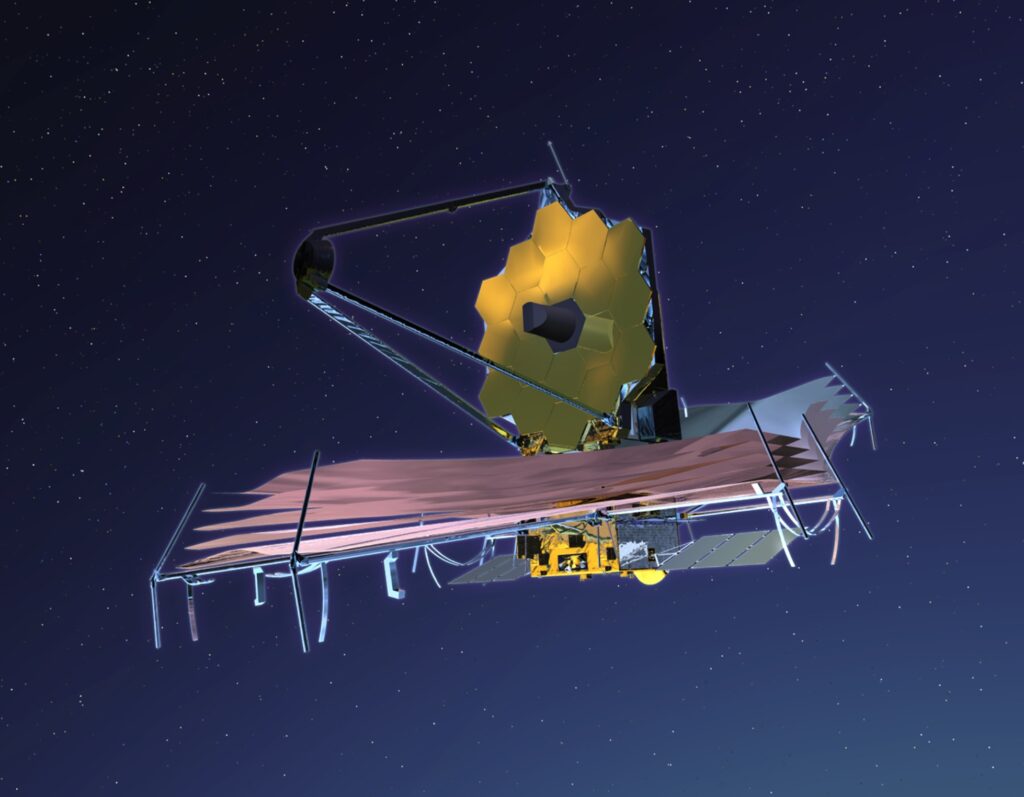The James Webb Space Telescope (JWST), NASA’s next space science observatory following Hubble, developed in partnership with ESA and CSA, successfully launched on December 25th, 2021. This next-generation telescope will offer astronomers the opportunity to observe the evolution and formation of stars and planets, exoplanet systems, and our solar system in ways never before possible.

What will JWST study?
The James Webb Space Telescope is joining a great legacy of space-based astronomy. NASA has done several things that revolutionized our understanding of the universe and our place within it. For example, the Hubble Space Telescope allowed us to see much further away from Earth than ever before. Likewise, it could give us an entirely new perspective of our planet when viewing pictures of it from outer space. By using advanced infrared-detecting technology, scientists will finally be able to view what was once unseen by human eyes: stars behind clouds of dust, water in other planets’ atmospheres and even the light emitted by the very first galaxies ever created!
The Hubble Space Telescope has gone as far back in time as it can go and has seen back about 500 million years after the Big Bang and the most distant galaxies we see today. But even with Hubble, scientists and astronomers have not been able to see very far back in time because of the limits of light travel through space (cosmological redshift: the expansion of the universe stretched the wavelengths beyond visible red to infrared). The James Webb telescope has explicitly been built to get a lot closer to the Big Bang since it was designed to be sensitive to infrared wavelengths, which allows us to look deeper into space.

In addition to observing the oldest light in the universe, infrared-detecting instruments are also crucial for measuring the rotation rate and, from that, determining the mass of galaxies. As light sources rotate away from Earth, the light is redshifted to longer wavelengths (infrared). From these measurements, astronomers determine how much total mass of a galaxy is needed for gravity to keep it from spinning apart. If a galaxy has less mass than its visible contents, it knows there must be dark matter—something that can’t be detected — holding it together!
Astronomers also hope that Webb will reveal more about the puzzling brown dwarf, an object that is neither a planet nor a star despite having some characteristics of both. Brown dwarfs are dim and yet also hot, making them ideal subjects for study with Webb’s infrared instruments.
How does it work?

The James Webb Space Telescope will be the largest infrared telescope ever launched, but it’s not all about size; it’s also about being able to capture light from farther away in space. This was made possible thanks to its 18 large segmented mirrors covering 6.5 meters wide to capture infrared light effectively. It is also crucial that the engineers have been able to design a system that will use carefully designed sun shields and radiate the heat away while immobilizing the temperature around equipment to prevent unwanted infrared interference with light being observed.
Launching such a large mirror into space is just one in a long list of exciting endeavours undertaken by the innovative engineers who helped design the telescope. A creative engineering solution was to use an origami-inspired folding telescope. This way, the sun shield and the mirrors were designed to unfold after the telescope separates from its launch vehicle.
Webb’s actual scientific observations are performed by four instruments, each specially designed to study different aspects of infrared light:
- Near-Infrared Camera (NIRCam): looks at near-infrared wavelengths. It can detect light from the earliest galaxies in the formation process, stars in nearby galaxies, young stars in the Milky Way, and objects from a distant region of our solar system called the Kuiper Belt. The instrument is also essential to exoplanet research;
- Near-Infrared Spectrograph (NIRSpec): multi-object, near-infrared spectrograph. A spectrograph is a device that breaks light up into its component colours for detailed analysis. NIRSpec detects near-infrared wavelengths and can observe more than 100 objects simultaneously. It is designed to study, among other things, star formation and the chemical composition of young, distant galaxies;
- Mid-Infrared Instrument (MIRI) with camera and spectrograph: designed to study distant stellar populations, the physics of newly forming stars, and the sizes of faintly visible comets and Kuiper Belt objects;
- Near-Infrared Image and Slitless Spectrograph (NIRISS): help point the telescope. It is used to observe both extraordinarily bright and faint objects. NIRISS will be particularly useful for studying the composition of exoplanet atmospheres.
Follow the mission
Remember to stay up to date on the mission, as the JWST will be able to answer outstanding questions about the Universe and make breakthrough discoveries in all fields of astronomy.
More information about the mission here: https://www.jwst.nasa.gov/





